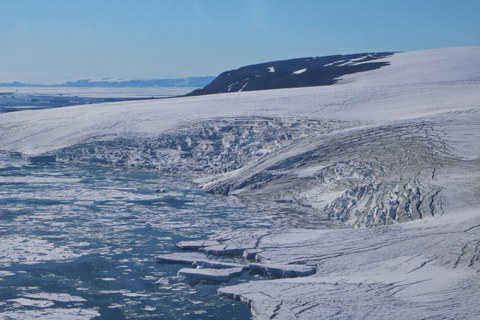Dec 12, 2016
TU Dresden presents the new data portal for glacier research

Kleiner Ausflussgletscher in der Nähe des Nioghalvfjerdsbrae (79Grad Gletscher)
Dresden-based geodesists are now able to explore in detail the flow rate of Greenland’s outlet glaciers, based on the Landsat data from 1972-2015
From 12 to 16 December 2016 the American Geophysical Union (AGU) gathers more than 24,000 scientists at its annual Fall Meeting in San Francisco (California, USA). The AGU Fall Meeting is the worldwide most important and largest geoscientific conference. All aspects of the Earth system and the global climate change will be discussed, but also methods and tools for their scientific investigation. Hereby, the continental ice sheets in Greenland and Antarctica play a decisive role.
At this conference, the Chair of Geodetic Earth System Research of TU Dresden presents its new data portal that enables to access flow-velocity fields for more than 300 outlet glaciers along the margin of the Greenland ice sheet. It is for the very first time that for many Greenland glaciers flow velocities can be tracked from 1972 until present.
The new web-based portal can be reached at https://data1.geo.tu-dresden.de/flow_velocity.
It enables to investigate the temporal evolution of the glacier flow velocity in different ways such as along profiles or in terms of time series for discrete points that are freely selectable at an interactive map.
So far, we included more than 37,000 optical multi-sensoral scenes from Landsat 1 to 8. More than 100,000 flow-velocity fields for more than 300 Greenland glaciers have been processed for the time period until 2012. For the subsequent years until 2015 we analyzed the flow-velocity fields for the fastest flowing glaciers. The processing is still ongoing while incorporating new recordings of Landsat 7 and 8 as well as further scenes made available by the Landsat Global Archive Consolidation effort.
To understand the evolution of the Greenland ice sheet and its reaction and feedback to global climate change it is decisive to investigate the most sensitive region: the margin of the ice sheet with its outlet glaciers. The observable changes are complex, comprising regions of acceleration of glacier flow and significant lowering of the ice surface height, but also regions with almost insignificant changes. In order to better understand the basic processes that are drivers for these changes, it is necessary to capture essential parameters that describe the evolution of the glaciers over a long time span. For this, our new dataportal provides a valuable tool.
The processed data can be downloaded and freely used by all scientists and interested laypersons after a short registration. For reference we like to ask you to refer to our paper published in 2015.
Additionally, further dataportals are available at to examine the gravimetric mass balance of the ice sheets in Greenland and Antarctica. The analysis of the mass balance is based on satellite gravimetry measurements using GRACE.
Reference:
Rosenau, R.; Scheinert, M.; Dietrich, R. (2015). A processing system to monitor Greenland outlet glacier velocity variations at decadal and seasonal time scales utilizing the Landsat imagery. Remote Sensing of Environment, Vol. 169, Pages 1-19,
https://doi.org/10.1016/j.rse.2015.07.012
Media inquiries:
TU Dresden
Professorship of Geodetic Earth System Research
Prof. Martin Horwath
Tel.: +49 (0) 351 463-34652
Dr.-Ing. Kristin Novotny
Tel.: +49 (0) 351 463-32192
Links:
Dataportal: https://data1.geo.tu-dresden.de/flow_velocity
AGU Fall Meeting: https://fallmeeting.agu.org/2016
